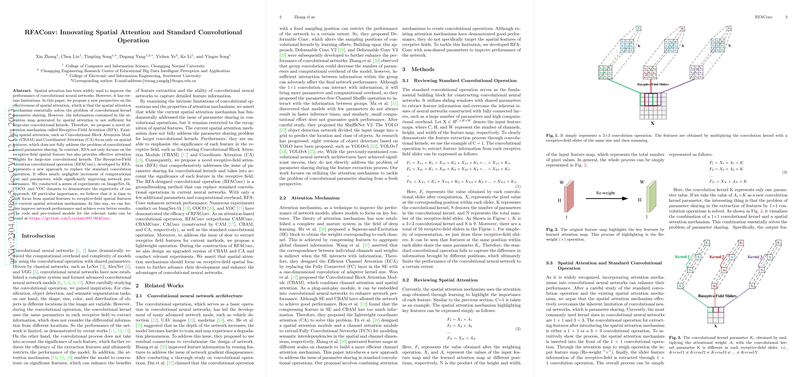An Analytical Overview of RFAConv: Innovating Spatial Attention and Standard Convolutional Operation
The paper "RFAConv: Innovating Spatial Attention and Standard Convolutional Operation" investigates the limitations of spatial attention mechanisms within the field of convolutional neural networks (CNNs), proposing an innovative approach that addresses these shortcomings. The authors describe the Receptive-Field Attention (RFA) mechanism that they hypothesize enhances network performance by addressing the convolutional kernel parameter sharing, especially for larger convolutional kernels.
Key Contributions
The proposal of the Receptive-Field Attention convolution operation (RFAConv) is a notable advancement in convolutional operations within CNNs. The authors argue that existing spatial attention mechanisms like CBAM and CA primarily focus on spatial features, thereby only partially addressing the problem inherent in parameter sharing among convolutional kernels. RFAConv distinguishes itself by not only focusing on spatial features but also offering effective attention over receptive-field spatial features that extend to large-size convolutional kernels.
The paper critiques traditional spatial attention mechanisms for not entirely solving the parameter sharing issue, especially as they become problematic with larger convolution kernels due to overlapping features. By conceptualizing and implementing RFAConv, the authors introduce a convolution operation that mitigates these problems while contributing minimal computational overhead and additional parameters.
Experimental Analysis
The paper provides a comprehensive evaluation of the proposed method through experiments conducted on standard datasets including ImageNet-1k, COCO, and VOC, showcasing the effectiveness of RFAConv. The results demonstrate improved performance over baseline networks augmented with typical attention mechanisms. For instance, RFAConv reports marked improvements in classification accuracy and object detection metrics compared to its counterparts while incurring minimal additional computational cost.
Implications and Future Perspectives
The introduction of RFAConv and its demonstrated efficiency highlight potential pathways for future research in enhancing CNN architectures. This approach could be particularly impactful in applications requiring high-performing, large-scale architectures that benefit from reduced parameter sharing and improved attention to spatial features.
Furthermore, the authors advocate for the shift in focus from conventional spatial features to receptive-field spatial features within attention mechanisms, which can lead to further performance gains. Such a pivot could reopen exploration into architectural modifications in CNNs, with RFAConv serving as a foundational component for new model designs that require efficient processing while maintaining high accuracy across tasks.
Conclusion
The research presented provides valuable insights into addressing existing limitations within spatial attention in CNNs. RFAConv emerges as a promising substitute for standard convolution operations, suggesting new directions for developing more efficient neural network models. Future work might look into integrating RFA-based operations in diverse machine learning models beyond CNNs, potentially influencing advancements in other deep learning subfields. The paper encourages continued exploration into attention-enriched convolutional operations to push the boundaries of network performance and efficiency.
